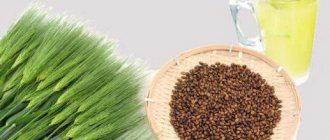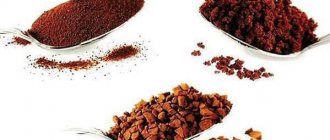General information
Coffee is a noble drink made from roasted and ground coffee beans. In 850 BC. raw grains were taken as an invigorating agent.
Only towards the end of the 17th century. They began to fry them and brew them with boiling water. In the 14th century the tree was brought to the Arabian Peninsula, then spread to the Ottoman Empire, then to Europe and India.
The most common varieties are Robusta and Arabica. They grow in Brazil, Colombia, Ethiopia, Honduras and India. Growing coffee is a costly and labor-intensive process.
The coffee tree needs indirect light, watering, insecticide treatment and weeding. The average fruiting period of a coffee tree is 60-70 years.
Ripe berries are picked by hand by seasonal workers. The harvest is subjected to careful processing: drying, frying and mechanical peeling. There is no uniform classification of coffee, so producing countries are guided by their own requirements.
Ludwig van Beethoven was a lover of strong coffee, who used 60 beans when brewing. The French poet Voltaire was also not inferior to Beethoven in preferences and drank 50 cups of coffee per day.
Is coffee with milk ok for pregnant and lactating women?
During pregnancy, women are concerned about the health of the unborn baby, monitor the development of the fetus, their nutrition and are afraid of causing harm, and this is understandable. The opinion of doctors regarding the possible dangers of caffeine was divided: some turned out to be ardent opponents, while others were supporters.
Most doctors are confident that moderate consumption of a drink made from lightly roasted beans or without caffeine will not harm the fetus, provided the mother has a healthy heart, since the beneficial properties of caffeine are greater than the possible harm.
Every woman during pregnancy or breastfeeding is required to consult with her doctor on the issue of nutrition and consumption of caffeine-containing drinks in order to eliminate or minimize harm to the unborn child.
History of the drink
It goes back a long way. The first to notice the invigorating effect of coffee were the people of the Ethiopian Oromo tribe, but there is no evidence to support this theory.
A more plausible version is that the shepherd Kaldim in 850 noticed the invigorating effect of coffee beans. However, this legend also has no substantiated arguments.
Ethiopia is considered the ancestor of coffee, from where the drink first came to Egypt and Yemen, then to the Near and Middle East, and by the end of the 19th century. spread throughout Italy, Indonesia and America.
Initially, in 1200, the drink was prepared in the form of a strong decoction from the shell of coffee beans; over time, they began to be completely roasted. It is unknown who came up with the idea of supplementing coffee with milk.
How to make delicious coffee with milk
Glasse. To prepare, cool the glass in the freezer compartment of the refrigerator.
- 100 g of ice cream is placed on the bottom;
- pour syrup over;
- carefully pour in the coffee.
Decorate the finished drink with whipped cream and sprinkle with chocolate chips.
Irish. Ingredients:
- sugar – 2 tsp;
- Irish whiskey – 20 ml;
- black coffee – 150 – 200 ml.
To prepare, preheat the glass. Add sugar and whiskey and mix. Decorate with whipped cream.
Reasons for adding milk to coffee
Milk improves the taste of coffee and reduces the negative effects of caffeine on the body. It contains essential amino acids and calcium, which is essential for the skeletal and cardiovascular systems.
The drink contains a large amount of vitamins, antioxidants, polyphenols, and a mixture of acids that improve the secretion of gastric juice.
The composition of grains is taken into account when drawing up the menu: everyday irritation of the gastric mucosa with acid causes gastritis. Before drinking coffee, you should have breakfast or a snack. If the pH level of the stomach is elevated and erosions are present, grain consumption should be limited.
Fragrant coffee with milk.
Coffee and milk create a large amount of toxins
The harm of coffee with milk is due to the high level of slagging in the body. The internal and external walls of blood vessels are susceptible to this effect immediately after drinking the drink. It’s a paradox, but a child’s body is able to cope with the harmful effects of coffee with milk, but an adult is not. It's all about the lack of special enzymes that disappear with age. An adult cannot break down casein.
For this reason, constipation, fecal stones may appear, and a small amount of toxins may be added to the blood. The effect of coffee with milk is especially harmful for men, who often suffer from rashes due to slagging. The only way out of this situation is to drink the drink once a week, but not on an ongoing basis. Otherwise, all the problems described above cannot be avoided.
Black coffee with milk increases the amount of necessary calcium in the body - that's what many consumers of the drink think. But everything is much more complicated than it might seem at first glance. Saturation of the body with calcium is impossible without a sufficient amount of silicon in the body. If you do not eat vegetables every day, then taking milk is of no use. Moreover, it can be harmful, since calcium will simply precipitate in the form of salts.
Important! Why can't you drink coffee with milk? It does not affect the leaching of calcium from the body, and even complicates this effect. Blockage of blood vessels, digestive disorders, constipation - this is just a small list of unfavorable changes in the body. Is it healthy to drink coffee with milk? Yes, because it softens the effect of the drink on the gastrointestinal tract and reduces pressure surges.
The harm to the human body is obvious, but there are also benefits in coffee with milk, you just have to limit your intake. If you do not have any gastrointestinal diseases or hypertension, then you can allow yourself 2-3 cups of drink per week.
Composition and calorie content
According to recent research by scientists, coffee contains more than 1 thousand substances.
Part of them:
- Carbohydrates. They provide the fullness of flavors and create a palette of coffee types. In Arabica this figure is 9%, in Robusta the mark borders between 3 and 7%. When sugar is roasted, some of the organic acids are transformed, which form the final taste of the drink.
- Squirrels. They make up 11-14%. Growing conditions, climate, grain processing methods and variety affect the protein content of the product. When heated, biochemical transformations lead to the formation of new substances responsible for the variety of varieties. For example, ketones and aldehydes give a sweet popcorn flavor, while furans give a sweetness.
- Fats. The level of plant lipids depends on the type of bean and roasting. In Arabica their content reaches 18%, in Robusta - 13%. Heat treatment makes the grains shiny and aromatic.
- Caffeine. The alkaloid gives the drink a characteristic bitter taste and protects the plant from parasites. The invigorating effect is associated with stimulation of the nervous system. A psychostimulant helps overcome fatigue, concentrate attention, and increase mental and physical performance. Doctors recommend taking no more than 0.3 g of caffeine at a time. Side effects may include sleep disturbance, irritability, and increased heart rate.
- Tannin. Gives coffee beans a brown color.
- Vitamins. In the process of frying grains, B vitamins are formed in them, which are necessary to maintain an optimal metabolic level. The product is rich in vitamins A, D, E, which promote the growth and division of body cells, increase immunity and normalize intestinal digestion.
- Minerals. Potassium and magnesium in grains regulate carbohydrate metabolism by producing insulin, which is responsible for the absorption of glucose.
Freshly prepared espresso coffee contains virtually no calories. 100 ml of natural product contains only 2 kcal, espresso - 4 kcal.
The table shows the energy value of 1 serving of some drinks (200 ml):
| Drink | Energy value (kcal) | Proteins (g) | Fat (g) | Carbohydrates (g) |
| Espresso | 19 | 0,2 | 0,4 | 3,3 |
| Cappuccino | 34 | 1,6 | 1,5 | 3,5 |
| Americano | 25 | 1 | 0 | 4 |
| Irish coffee | 416 | 7 | 17 | 60 |
| Latte | 112 | 10,8 | 0,9 | 15 |
| Mocha | 326 | 11 | 15 | 36 |
| Caramel macchiato | 240 | 10 | 7 | 34 |
The use of coffee with milk in folk medicine
Traditional methods of treating many diseases are more effective than drug therapy. When using traditional recipes, it is necessary to control the freshness of the products, take into account the frequency of intake and preparation rules.
Ginger coffee
Coffee, milk, and ginger are used to prepare a tasty, healthy drink that can influence the mechanism of preventing the spread of cancer cells, as well as improving brain activity. To prepare, take 2 parts coffee, 1 part milk, 50 g chopped ginger root. The root is poured into a hot drink and drunk in small sips.
Coffee with milk and cinnamon
Cinnamon powder is often added to cappuccino latte and macchiato.
Drinking cinnamon may have several beneficial effects:
- Antiviral, antibacterial effects that help relieve cold symptoms.
- Normalization of blood sugar, insulin production. This effect can be achieved by using coffee drinks with minimal milk content and increased amounts of cinnamon powder.
- Improving brain function, accelerating metabolic processes. This phenomenon of a coffee-cinnamon drink is in demand when creating a diet menu. Cinnamon improves metabolic processes, which helps with weight loss.
Types of milk-based coffee
Milk is added in different proportions to freshly brewed coffee with a tart and rich taste. Cappuccino, latte and macchiato are prepared from a mixture of 2 products.
All types of coffee in the article:
Cappuccino
Appeared back in the 18th century. thanks to the Capuchin monks, whose members wore brick-red robes. In Austria, the drink was prepared from coffee, cream and yolks.
Another version says that the red-orange nasturtium flowers were cup-shaped. However, the official history of cappuccino dates back to the 20th century, when it spread throughout Italy.
Milk and coffee are required for preparation. Arabica or a blend of Arabica and Robusta is suitable. The recommended list includes milk, “Milk River” or Rioba with a fat content of 3.5%. Before frothing milk, it should be cooled to 2-6ºC. If you don't have a coffee machine, it's better to take cream.
Instructions:
- Pour coffee into a warm 200 ml cup;
- froth warm milk (temperature - 60-70ºC) with a cappuccino maker until a strong foam forms;
- Slowly introduce the foam into the coffee base, trying to pour the milk along the side of the cup.
A properly prepared cappuccino is divided into layers. In coffee shops, the finished product is decorated with chocolate and cinnamon, making unusual designs.
Cappuccino with large foam.
Latte
In Spain it is served in small café con leche cups, in France - café au lait. In 1867, the English press mentioned that in coffee shops in Italy travelers were served a drink less strong than cappuccino - latte. Demand for it came in 1980 from people who loved unsaturated grain decoctions.
The preparation of a latte is no different from a cappuccino. The difference lies in the proportions of milk and coffee. You can supplement it with cinnamon, vanilla or chocolate.
Milk with a fat content of 3.5% is difficult to form foam, and a 2% product deprives the latte of a pleasant taste with a creamy tint. It is better to choose a fat content of 2.5-3.2%.
A classic latte is prepared from a mixture of espresso (50 ml) and milk (150 ml). First pour the coffee into a small cup, and then slowly add the frothed milk. An indicator of proper cooking is the formation of foam on top, and both products are mixed.
Macchiato
This is espresso with milk not exceeding 1/2 the volume of coffee. The history of the origin of macchiato begins in 1930 in Italy. Curious Italians had questions about the amount of milk added to coffee.
The baristas called the new drink "macchiato", which translated from their native language means "spotted" (due to the appearance of light spots on the surface).
For preparation you need a mixture of Arabica and 10-15% Robusta. You should not take a lot of robusta, which gives a bitter aftertaste. To fully develop the taste, you should brew the drink in filtered water.
Tap liquid, like boiled liquid, will spoil the taste. Suitable milk fat content is 2.5-3.2%; it can be replaced with baked product. For lactose intolerance, use plant milk.
Macchiato ingredients:
- espresso - 35 ml;
- milk (temperature - 60ºC) - 15 ml.
Freshly brewed coffee is poured into a cup, and milk pre-whipped with a cappuccino maker is poured into it. Next, add cane sugar, a pinch of vanillin, and caramel syrup. For beauty, the foam is sprinkled with chocolate or ground cinnamon.
Caramel macchiato.
Cappuccino
The basis of cappuccino is espresso and milk. To prepare a cappuccino, it is heated and whipped into foam. The trick is to ensure that the milk contains both foam and liquid. Frothed milk is poured into a cup of hot espresso, forming a thick foam. In the process of adding milk, it is partially mixed with coffee, so the foam on the finished cappuccino has brownish stains around the edges.
Standard cappuccino proportions:
- 1/3 espresso
- 1/3 milk
- 1/3 whipped foam of dense, smooth consistency
Cappuccino is recognized as the most popular recipe in European and American coffee shops. Its volume can vary from 150 to 200 ml, depending on the establishment, but a mandatory serving rule is that the foam should rise slightly above the edge of the cup. The dense consistency allows the foam to retain its shape and not spill out over the top.
Cappuccino is sometimes sprinkled with additives on top - cinnamon, chocolate, cocoa. It is drunk without stirring the foam, passing the coffee with milk through the silky foam structure with each sip. Connoisseurs of the drink do not add sugar to it in order to more fully experience the nutty and milky bouquet.
Beneficial features
The Swiss company Nestle conducted research on the effects of milk on human health. It was possible to establish the time during which polyphenols appear in the blood.
The analysis showed that the type of milk does not affect the ability of substances to enter the blood faster. This does not affect the antioxidant capacity.
Experiments have proven that adding a small amount of milk reduces the invigorating effect. Caffeine takes longer to digest, so its effects are longer lasting.
Protection from diseases
The drink contains antioxidants in high doses. They have antibacterial, antiviral and anti-inflammatory effects.
Cappuccino, latte or macchiato lowers blood pressure. Regular consumption of the product in reasonable quantities enhances the body's protective function.
Reducing the risk of cancer
Drinking 1 cup of coffee a day can reduce the risk of liver cancer by 15%. Women are less likely to get breast cancer. Antioxidants prevent premature aging of cells and improve immunity.
Coffee with milk during weight correction
Diet is a scary word for many women who have to deal with this process constantly. In many cases of weight correction, the consumption of dairy products is encouraged. But is coffee with milk bad for your health? We are talking specifically about a person who is on a diet.
Weight correction should not only reduce the “sides”, but also “unload” our body, and coffee with milk, as we wrote earlier, creates slagging. On the other hand, an invigorating drink speeds up metabolism, burns fat reserves and really helps you lose weight. But there is a main “but” - milk neutralizes the property of coffee as an antioxidant and there will be no weight loss effect. How to drink this drink correctly in this case? Removing milk from it is the only sure method. If you are thinking about why coffee with milk is harmful for women, then you can breathe a sigh of relief; there are no particular negative effects. But if you are on a diet, then you should give up this drink and switch to black coffee.
Effect on the body
There is a popular belief that coffee is addictive. Many people consider grains to be harmful and avoid them altogether. The effect of an invigorating drink on the body of children, pregnant women and nursing mothers is very different.
Female
Caffeine negatively affects hormonal levels, causing mood swings. If you have diseases of the reproductive system, such as cysts or polycystic ovary syndrome, drinking too much can aggravate the course of the pathology.
When planning a pregnancy, it is better to give up espresso, latte and even cappuccino. Daily consumption of the drink leads to the appearance of bags under the eyes, discoloration of tooth enamel, and swelling.
A cup of coffee in the morning will give you energy for the whole day.
Male
Coffee has both positive and negative effects on men. When drinking 1-2 cups a day, you feel a surge of strength and improve your performance.
A high dosage of caffeine leads to disturbances in the gastrointestinal tract and nervous system. Caffeine greatly affects the functioning of the heart and the condition of blood vessels.
Regular consumption of coffee decoction often causes addiction. Coffee also affects a man’s reproductive ability, which is reflected in a decrease in sperm motility.
The drink improves performance.
In children
Children under 7 years of age are not recommended to drink coffee. As an exception, it is possible to give children over 6 years of age a weak decoction with milk once a month. Often teenagers are addicted to instant drinks or coffee from the machine, and this is not recommended even for adults. If you have acne, you should limit your consumption of types of coffee such as lattes, macchiatos and cappuccinos.
During pregnancy
Pregnant women are allowed to drink latte, macchiato and cappuccino no more than 2 times a month. Coffee changes hormonal levels, which causes mood swings, anxiety, and fatigue.
The drink constricts blood vessels, which disrupts the nutrition of the fetus, and this can lead to asphyxia. Do not forget about the leaching of calcium from the body, which results in rickets.
Coffee can trigger the development of gestosis and nausea. It is strictly forbidden to drink it for the first 4 months after childbirth if a woman is breastfeeding.
Coffee is not recommended for pregnant women.
How to drink coffee without harm to your health?
We invite you to familiarize yourself with several facts that will help you make the right choice.
You should not drink coffee if you are on a therapeutic diet or do not want to gain weight.
One cup of black coffee contains 4.7 calories - quite harmless to your figure. You can compare one cup of coffee with milk and sugar, which has about 50 calories. If you are on a diet, you should not drink latte or cappuccino. Constant use can affect your figure. It is better to prefer black coffee.
It is also worth remembering that any diet is a necessary measure. Usually, people adhere to a special diet for various diseases or in order to lose excess weight.
There are a huge number of diets that recommend consuming fermented milk products. But finding a diet that allows you to drink fresh milk is quite difficult.
The main goal of the diet is to “unload” the body. Dietary nutrition allows the body not to waste energy on digesting heavy food, but to use it to normalize metabolic processes and cleanse toxins.
There are special diets for weight loss. In some of them, nutritionists recommend drinking coffee several times a day every day, since this drink has only a positive effect: caffeine increases the metabolic rate, promotes the “burning” of fat deposits, fights cellulite, and the chlorogenic acid contained in coffee acts as a powerful antioxidant .
But you should be careful: you should not get carried away only with black coffee. Coffee with milk reduces the effects of caffeine and neutralizes chlorogenic acid. It turns out that if you drink such a mixture while following a diet, then all your efforts will be in vain. You shouldn’t constantly limit yourself to food, experience inconvenience and ruin the whole diet process by drinking milk.
Milk is not a high-calorie product: its calorie content depends on its fat content, on average it is 40-70 kcal. For those who regularly follow a diet and count calories, a difference of 10-20 kcal will not have a strong impact, so you should not deprive yourself of such pleasure. You can give preference to skim milk. In this case, you will have to slightly reduce your diet for the day.
It's better to drink in the evenings
Black coffee increases energy and mental performance because it does not contain milk or cream, which weakens the effect. If you like to drink coffee in the evenings, then you may experience insomnia.
It is possible to prevent this problem by adding a small amount of milk. Then you can not only enjoy the drink, but also prepare yourself for a sound and healthy sleep. If you already have problems sleeping at night, then you should not drink coffee in the evenings.
For those with high gastrointestinal acidity
People with acidity problems should avoid this drink, as caffeine increases the pH level. Black bean coffee with milk is milder. But don’t forget to drink plenty of clean water and add foods high in water content to your diet.
The drink prevents the development of esophageal cancer
Many coffee lovers believe that it can cause esophageal cancer. It is known that hot coffee can lead to thermal burns of some tissues of the esophagus, which can subsequently provoke the formation of a malignant tumor. But if you add a small amount of milk to your coffee, the temperature of the drink will become lower and your stomach will be safe.
The mixture is good for bones
Black coffee has a major disadvantage - it interferes with the absorption of elements beneficial to the body, especially calcium. But if you add a little milk or cream to your coffee, it will help replenish the lost calcium.
Be sure to read: What is green coffee and is it really effective for weight loss?
During pregnancy
Women in an interesting position sometimes cannot cope with the strong desire to drink a cup of coffee with milk. Indeed, coffee with milk is much healthier for pregnant women than black coffee. But don’t get too carried away: the permissible limit is 1-2 times per month.
How does coffee affect the body of a pregnant woman?
- changes hormonal levels, as a result of which a pregnant woman may experience anxiety and mood swings;
- inhibits the absorption of iron, which can lead to anemia;
- constricts blood vessels, as a result of which the supply of nutrients to the fetus deteriorates;
- promotes the loss of calcium from bone tissue, which leads to tooth damage. Milk cannot compensate for this deficiency. Coffee is especially dangerous for pregnant women after 30 years of age;
- in some women it provokes nausea and increases toxicosis.
When breastfeeding
The Internet is full of articles that say that nursing mothers should give up coffee and should not be given to children under 7 years of age.
Up to 4 months, the child’s body can only accumulate caffeine. Together with mother's milk, 1–1.5% of caffeine enters the baby's stomach. It turns out that after each cup of coffee, black or with milk, the child receives 0.5–1 mg of caffeine through mother's milk. And all this is retained in the baby’s body. Mothers who drink coffee should not then wonder why their child constantly has insomnia and whims.
If the baby is already 6 months old, then the nursing mother can allow herself 1-2 cups of coffee per month at least 3 hours before feeding, but you need to be prepared for the fact that the breastfeeding baby may become capricious.
In addition to all of the above, caffeine also affects the composition of the blood: it creates obstacles to the absorption of iron. It is worth adding that the grain drink constricts blood vessels, resulting in problems with lactation.
Children and teenagers
You should not offer coffee to children under 7 years of age. An exception is if your child is over 6 years old and asks for it. You can prepare him a coffee drink from milk and 1-2 teaspoons of weak natural coffee. If you do not add sugar, then perhaps the child will cool down and forget about this drink.
After the age of 12, teenagers learn about chain coffee shops and coffee from a vending machine. It will be better if by this time he has already tried real coffee at home and felt the difference between a quality drink and a dubious fake. The choice should be made in favor of a drink with milk. But if your child has problems with the gastrointestinal tract, constant acne, or is prone to constipation, then it is recommended to stop drinking this drink.
Possibility of use during diets
The main task of diets is to cleanse the body of toxins and waste, and relieve the burden on the digestive system. To do this, the menu includes light foods that are low in calories.
Coffee without added sweeteners, milk or cream helps in weight loss. Caffeine enhances metabolism, promoting lipolysis of fat deposits.
Sweet latte, cappuccino and macchiato weaken the effect of this substance and neutralize acids. They do not help you get rid of excess weight, but only add kilograms.
Caffeine promotes weight loss.
How many calories are in coffee with milk?
During a break at work or during a meeting in a cafe, a cup of an invigorating drink will charge the body with energy from 58 kcal per 100 ml. A snack is usually a croissant, sandwich or cake, the beneficial properties of which cannot be discussed. To maintain your figure, it is recommended to replace baked goods with healthy sweets: marmalade, dried fruits or marshmallows. Such a delicacy will not cause harm, and thanks to the beneficial properties of dried fruits, it will only increase immunity.
Frequent consumption of coffee with cream will not benefit those who are struggling with excess weight. The high fat content of cream improves the taste, but adds extra pounds.
Contraindications for use and harm to the body
In rare cases, coffee with milk causes lymph stagnation. This is evidenced by swelling, the appearance of flatulence, and specific discharge in women.
Rapid weight gain is a clear sign of problems in the body caused by caffeine. We must not forget about psychological dependence when abusing coffee beans.
The following groups of people should refuse the drink:
- hypertensive patients (vasoconstriction increases blood pressure);
- people suffering from mental illness (caffeine irritates the nervous system, causing rapid heartbeat, anxiety, and panic attacks);
- pregnant and nursing mothers to prevent the development of fetal pathology.
Many people argue about the compatibility of coffee and milk, but this combination allows you to prepare 3 drinks at once: cappuccino, latte and macchiato. Milk weakens the effect of caffeine on the body, giving a delicate taste to the invigorating mixture. If you are lactose intolerant, you may want to try other types of milk.
Contraindications
But it should be noted that not everyone can drink coffee with milk. There is a large category of people for whom this drink is strictly contraindicated. Patients with cardiac ischemia, atherosclerosis, and hypertensive patients are not recommended to drink coffee with milk. People who suffer from kidney disease, glaucoma, regular insomnia and increased excitability should also abstain from it. It is also not advisable to give coffee with milk to children and the elderly.
It is interesting to know that a cup of aromatic cocktail will bring maximum benefit if you drink it in the first half of the day. But after a hearty lunch or on an empty stomach, coffee with milk promises nothing but harm.
Instant coffee with milk is less healthy than natural coffee, which is often drunk by people on a diet. It is known that ground coffee with milk promotes weight loss, as it intensively burns fat. But you must drink this drink without sugar.
So, is it good or bad? Coffee with milk, due to the presence of calcium, prevents the development of osteoporosis, which is important for women over 45 years of age. In addition, it is clear that milk, due to its presence in the drink, reduces the proportion of caffeine in the volume.
When is it not recommended to drink coffee with milk?
The drink should not be consumed if you have certain diseases.
Problems digesting dairy products
The drink is contraindicated in case of lactase deficiency and milk protein allergy. These conditions are recognized by the following signs. Lactase deficiency manifests itself in the form of intestinal pain and diarrhea.
When this enzyme is deficient, sugar enters the colon and promotes the activation of intestinal microbes. The disease may be congenital or develop with age. Lactase deficiency occurs due to chronic diseases, poor diet and intestinal infections.
In case of allergies, milk proteins (albumin) enter the bloodstream in an undigested state. The body perceives them as foreign substances, resulting in an allergic reaction: runny nose, cough, rashes and itching on the skin, asthma attacks.
Do you like coffee with milk?
Yes
No
Stomach problems
Do not drink coffee with milk if you have gastritis or stomach ulcers. It increases acidity, which leads to heartburn and exacerbation of the disease. If you drink it on an empty stomach, you can provoke the development of cancer.
Other problems
You should avoid coffee if you have the following diseases:
- hypertension;
- neurological disorders;
- pancreatitis;
- cholecystitis;
- insomnia;
- cardiovascular pathologies.
In such conditions, the drink can cause harm to health even in diluted form.










